Organizational Behaviour and Leadership
VerifiedAdded on 2020/10/22
|15
|4034
|458
AI Summary
This assignment delves into the concept of organisational behaviour, focusing on motivation theories such as positive and negative motivation. It also examines different leadership styles, including directive, achievement-oriented, participative, and supportive leadership. The path goal theory is discussed as a framework for leaders to guide their followers along a specific path towards achieving goals.
Contribute Materials
Your contribution can guide someone’s learning journey. Share your
documents today.
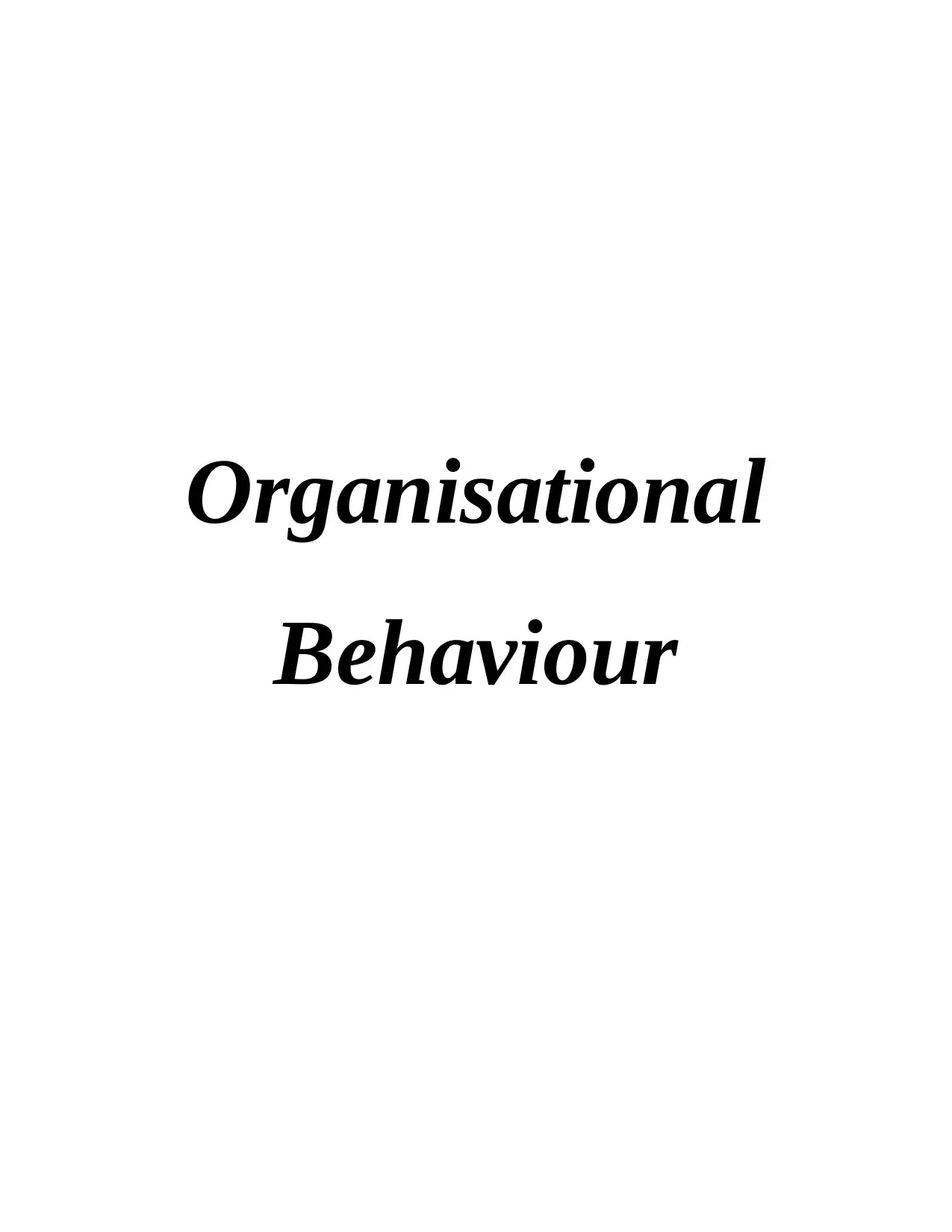
Organisational
Behaviour
Behaviour
Secure Best Marks with AI Grader
Need help grading? Try our AI Grader for instant feedback on your assignments.
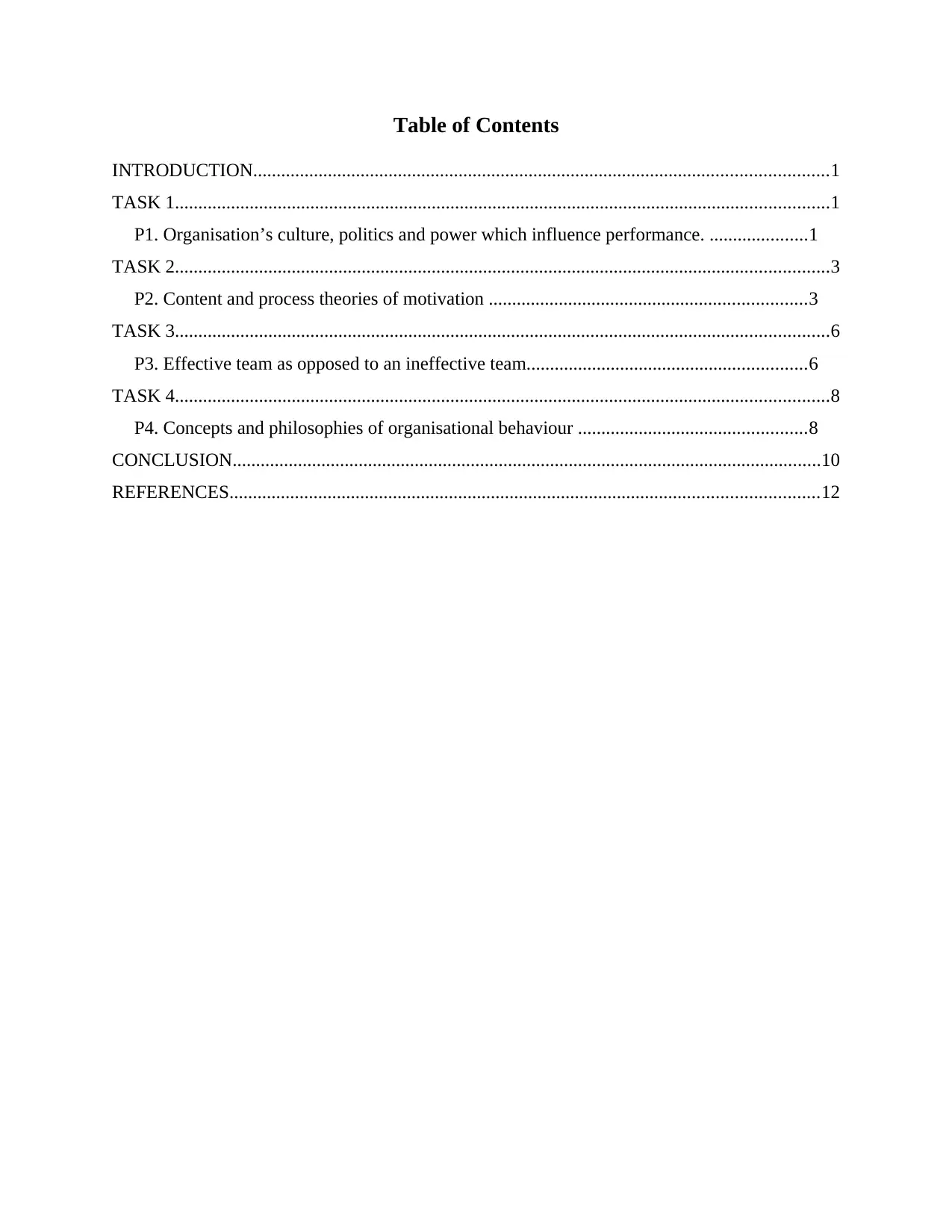
Table of Contents
INTRODUCTION...........................................................................................................................1
TASK 1............................................................................................................................................1
P1. Organisation’s culture, politics and power which influence performance. .....................1
TASK 2............................................................................................................................................3
P2. Content and process theories of motivation ....................................................................3
TASK 3............................................................................................................................................6
P3. Effective team as opposed to an ineffective team............................................................6
TASK 4............................................................................................................................................8
P4. Concepts and philosophies of organisational behaviour .................................................8
CONCLUSION..............................................................................................................................10
REFERENCES..............................................................................................................................12
INTRODUCTION...........................................................................................................................1
TASK 1............................................................................................................................................1
P1. Organisation’s culture, politics and power which influence performance. .....................1
TASK 2............................................................................................................................................3
P2. Content and process theories of motivation ....................................................................3
TASK 3............................................................................................................................................6
P3. Effective team as opposed to an ineffective team............................................................6
TASK 4............................................................................................................................................8
P4. Concepts and philosophies of organisational behaviour .................................................8
CONCLUSION..............................................................................................................................10
REFERENCES..............................................................................................................................12
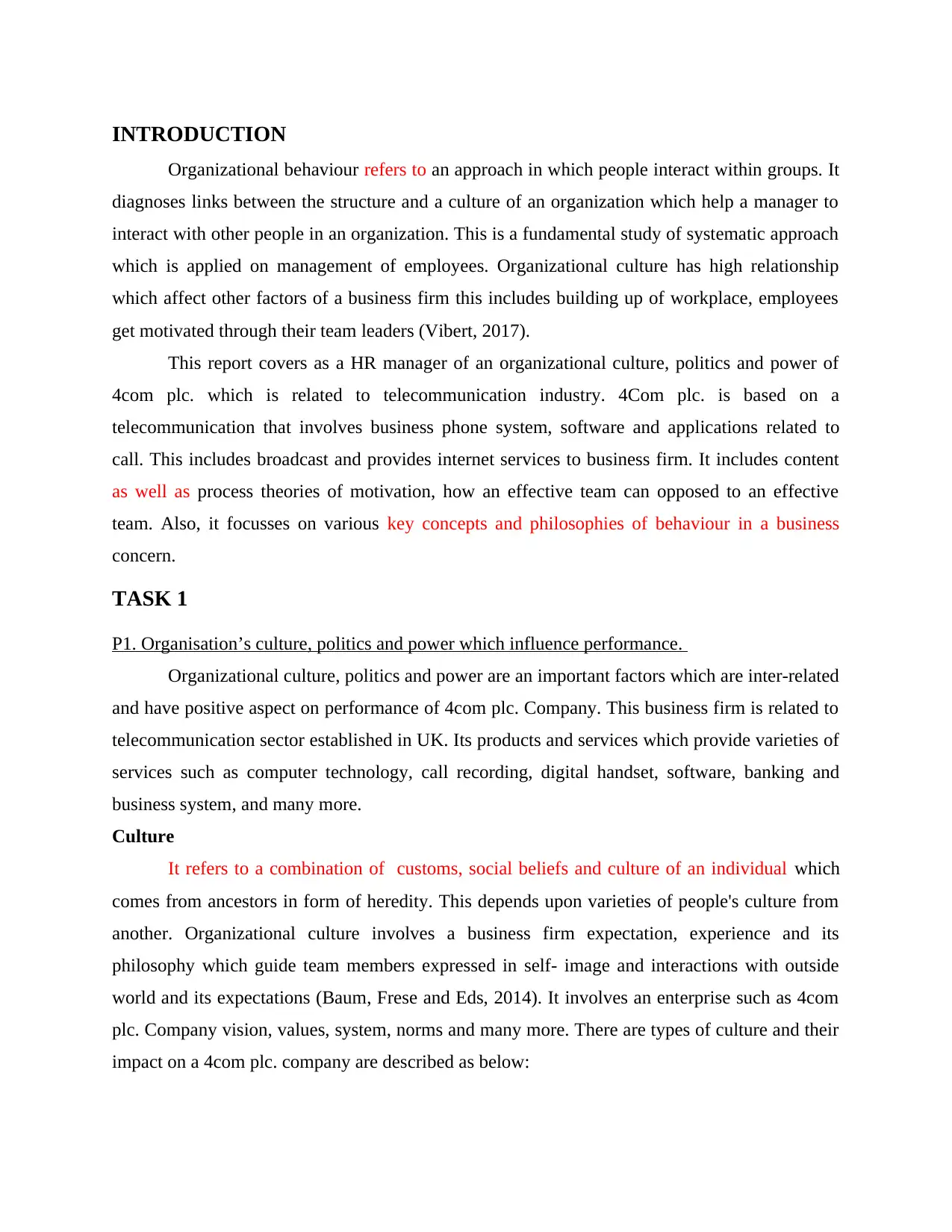
INTRODUCTION
Organizational behaviour refers to an approach in which people interact within groups. It
diagnoses links between the structure and a culture of an organization which help a manager to
interact with other people in an organization. This is a fundamental study of systematic approach
which is applied on management of employees. Organizational culture has high relationship
which affect other factors of a business firm this includes building up of workplace, employees
get motivated through their team leaders (Vibert, 2017).
This report covers as a HR manager of an organizational culture, politics and power of
4com plc. which is related to telecommunication industry. 4Com plc. is based on a
telecommunication that involves business phone system, software and applications related to
call. This includes broadcast and provides internet services to business firm. It includes content
as well as process theories of motivation, how an effective team can opposed to an effective
team. Also, it focusses on various key concepts and philosophies of behaviour in a business
concern.
TASK 1
P1. Organisation’s culture, politics and power which influence performance.
Organizational culture, politics and power are an important factors which are inter-related
and have positive aspect on performance of 4com plc. Company. This business firm is related to
telecommunication sector established in UK. Its products and services which provide varieties of
services such as computer technology, call recording, digital handset, software, banking and
business system, and many more.
Culture
It refers to a combination of customs, social beliefs and culture of an individual which
comes from ancestors in form of heredity. This depends upon varieties of people's culture from
another. Organizational culture involves a business firm expectation, experience and its
philosophy which guide team members expressed in self- image and interactions with outside
world and its expectations (Baum, Frese and Eds, 2014). It involves an enterprise such as 4com
plc. Company vision, values, system, norms and many more. There are types of culture and their
impact on a 4com plc. company are described as below:
Organizational behaviour refers to an approach in which people interact within groups. It
diagnoses links between the structure and a culture of an organization which help a manager to
interact with other people in an organization. This is a fundamental study of systematic approach
which is applied on management of employees. Organizational culture has high relationship
which affect other factors of a business firm this includes building up of workplace, employees
get motivated through their team leaders (Vibert, 2017).
This report covers as a HR manager of an organizational culture, politics and power of
4com plc. which is related to telecommunication industry. 4Com plc. is based on a
telecommunication that involves business phone system, software and applications related to
call. This includes broadcast and provides internet services to business firm. It includes content
as well as process theories of motivation, how an effective team can opposed to an effective
team. Also, it focusses on various key concepts and philosophies of behaviour in a business
concern.
TASK 1
P1. Organisation’s culture, politics and power which influence performance.
Organizational culture, politics and power are an important factors which are inter-related
and have positive aspect on performance of 4com plc. Company. This business firm is related to
telecommunication sector established in UK. Its products and services which provide varieties of
services such as computer technology, call recording, digital handset, software, banking and
business system, and many more.
Culture
It refers to a combination of customs, social beliefs and culture of an individual which
comes from ancestors in form of heredity. This depends upon varieties of people's culture from
another. Organizational culture involves a business firm expectation, experience and its
philosophy which guide team members expressed in self- image and interactions with outside
world and its expectations (Baum, Frese and Eds, 2014). It involves an enterprise such as 4com
plc. Company vision, values, system, norms and many more. There are types of culture and their
impact on a 4com plc. company are described as below:

Power culture: It can be held by few individuals who are influence to spread or expand a
business firm of 4com plc company. It is usually a strong culture, but it can then too
swiftly affect an organizational environment. There are few rules and regulations in a
power culture which explains about what is to happen.
Role culture: This culture is based on a role that is based on rules. It is highly controlled,
with everyone who knows their roles and responsibility of employees. It is build on
organizational structure with a long chain of command.
Task culture: This culture is considered when teams in 4com plc company are assumed
to address specific problems and projects. Task culture is proves effectively by
determining team skills and their capabilities by using dynamic environment.
Person culture: This type of office culture provides a set of rules and regulations that
employees follows in 4com plc company. Workers know what they get when employees
sign-up there work, it is tough culture that employees are not micro- managed by given
performance. It is run and operates by government agencies (Coccia and Rolfo, 2013).
Power
It refers to skills that help in influencing other people. It refers to capacity that affect
behaviour of subordinate which also have power to control. This is an exchange relationship that
occurs in transaction between an employee and employer. It is essential in every company to
control their organization. This can be an owner or by top management which can get authority
by overseen the work performance.
Types of power and their aspects on 4com plc. Company are given below:
Reward power: It is based upon managers ability to control reward by employee want. It
can be done as increment in salary, bonuses, promotion and providing offers to
employees such as trip, provide discount coupons and so on. It is based on wealth is
power.
Coercive power: It is opposite of reward power. It is based upon an individual or
manager's ability to influence other by threats or punishment. This power helps to control
behaviour of workers by ensuring to adhere business policies and norms.
Legitimate power: This is also known as situation power. It is held by a company owner
such as CEO or director of firm. Legitimate power helps to hold organizational hierarchy
which assist to control and measure the contribution of each and every person of 4com
2
business firm of 4com plc company. It is usually a strong culture, but it can then too
swiftly affect an organizational environment. There are few rules and regulations in a
power culture which explains about what is to happen.
Role culture: This culture is based on a role that is based on rules. It is highly controlled,
with everyone who knows their roles and responsibility of employees. It is build on
organizational structure with a long chain of command.
Task culture: This culture is considered when teams in 4com plc company are assumed
to address specific problems and projects. Task culture is proves effectively by
determining team skills and their capabilities by using dynamic environment.
Person culture: This type of office culture provides a set of rules and regulations that
employees follows in 4com plc company. Workers know what they get when employees
sign-up there work, it is tough culture that employees are not micro- managed by given
performance. It is run and operates by government agencies (Coccia and Rolfo, 2013).
Power
It refers to skills that help in influencing other people. It refers to capacity that affect
behaviour of subordinate which also have power to control. This is an exchange relationship that
occurs in transaction between an employee and employer. It is essential in every company to
control their organization. This can be an owner or by top management which can get authority
by overseen the work performance.
Types of power and their aspects on 4com plc. Company are given below:
Reward power: It is based upon managers ability to control reward by employee want. It
can be done as increment in salary, bonuses, promotion and providing offers to
employees such as trip, provide discount coupons and so on. It is based on wealth is
power.
Coercive power: It is opposite of reward power. It is based upon an individual or
manager's ability to influence other by threats or punishment. This power helps to control
behaviour of workers by ensuring to adhere business policies and norms.
Legitimate power: This is also known as situation power. It is held by a company owner
such as CEO or director of firm. Legitimate power helps to hold organizational hierarchy
which assist to control and measure the contribution of each and every person of 4com
2
Secure Best Marks with AI Grader
Need help grading? Try our AI Grader for instant feedback on your assignments.
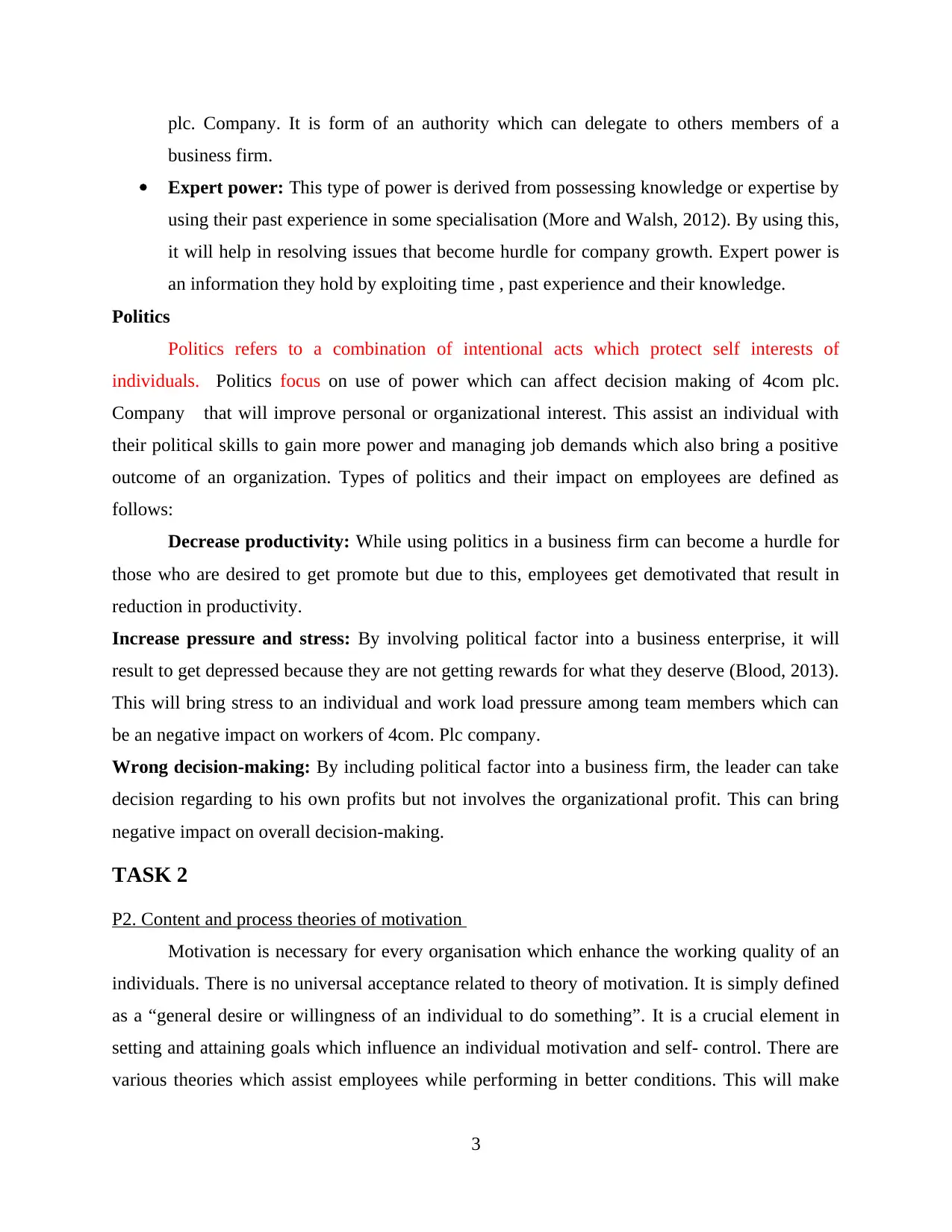
plc. Company. It is form of an authority which can delegate to others members of a
business firm.
Expert power: This type of power is derived from possessing knowledge or expertise by
using their past experience in some specialisation (More and Walsh, 2012). By using this,
it will help in resolving issues that become hurdle for company growth. Expert power is
an information they hold by exploiting time , past experience and their knowledge.
Politics
Politics refers to a combination of intentional acts which protect self interests of
individuals. Politics focus on use of power which can affect decision making of 4com plc.
Company that will improve personal or organizational interest. This assist an individual with
their political skills to gain more power and managing job demands which also bring a positive
outcome of an organization. Types of politics and their impact on employees are defined as
follows:
Decrease productivity: While using politics in a business firm can become a hurdle for
those who are desired to get promote but due to this, employees get demotivated that result in
reduction in productivity.
Increase pressure and stress: By involving political factor into a business enterprise, it will
result to get depressed because they are not getting rewards for what they deserve (Blood, 2013).
This will bring stress to an individual and work load pressure among team members which can
be an negative impact on workers of 4com. Plc company.
Wrong decision-making: By including political factor into a business firm, the leader can take
decision regarding to his own profits but not involves the organizational profit. This can bring
negative impact on overall decision-making.
TASK 2
P2. Content and process theories of motivation
Motivation is necessary for every organisation which enhance the working quality of an
individuals. There is no universal acceptance related to theory of motivation. It is simply defined
as a “general desire or willingness of an individual to do something”. It is a crucial element in
setting and attaining goals which influence an individual motivation and self- control. There are
various theories which assist employees while performing in better conditions. This will make
3
business firm.
Expert power: This type of power is derived from possessing knowledge or expertise by
using their past experience in some specialisation (More and Walsh, 2012). By using this,
it will help in resolving issues that become hurdle for company growth. Expert power is
an information they hold by exploiting time , past experience and their knowledge.
Politics
Politics refers to a combination of intentional acts which protect self interests of
individuals. Politics focus on use of power which can affect decision making of 4com plc.
Company that will improve personal or organizational interest. This assist an individual with
their political skills to gain more power and managing job demands which also bring a positive
outcome of an organization. Types of politics and their impact on employees are defined as
follows:
Decrease productivity: While using politics in a business firm can become a hurdle for
those who are desired to get promote but due to this, employees get demotivated that result in
reduction in productivity.
Increase pressure and stress: By involving political factor into a business enterprise, it will
result to get depressed because they are not getting rewards for what they deserve (Blood, 2013).
This will bring stress to an individual and work load pressure among team members which can
be an negative impact on workers of 4com. Plc company.
Wrong decision-making: By including political factor into a business firm, the leader can take
decision regarding to his own profits but not involves the organizational profit. This can bring
negative impact on overall decision-making.
TASK 2
P2. Content and process theories of motivation
Motivation is necessary for every organisation which enhance the working quality of an
individuals. There is no universal acceptance related to theory of motivation. It is simply defined
as a “general desire or willingness of an individual to do something”. It is a crucial element in
setting and attaining goals which influence an individual motivation and self- control. There are
various theories which assist employees while performing in better conditions. This will make
3
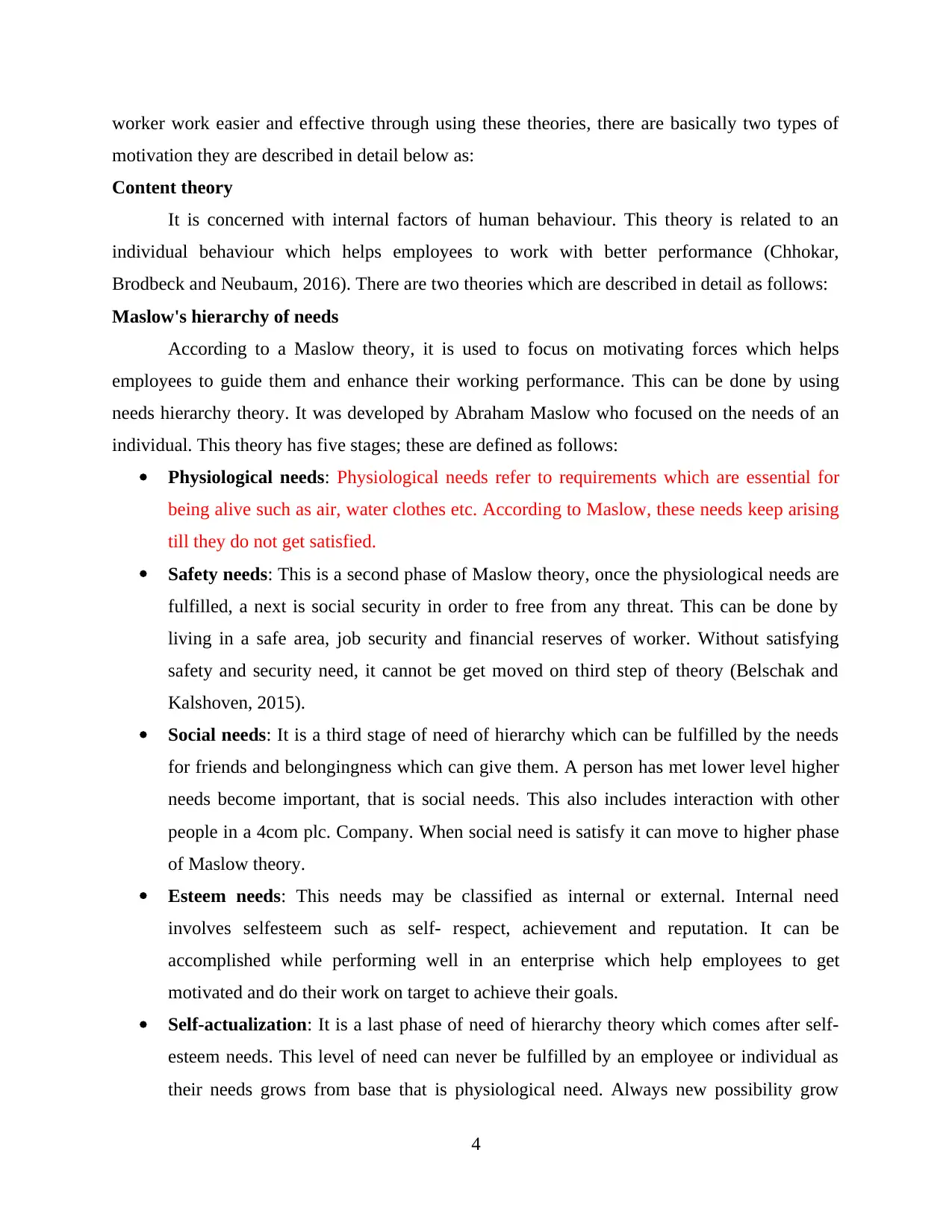
worker work easier and effective through using these theories, there are basically two types of
motivation they are described in detail below as:
Content theory
It is concerned with internal factors of human behaviour. This theory is related to an
individual behaviour which helps employees to work with better performance (Chhokar,
Brodbeck and Neubaum, 2016). There are two theories which are described in detail as follows:
Maslow's hierarchy of needs
According to a Maslow theory, it is used to focus on motivating forces which helps
employees to guide them and enhance their working performance. This can be done by using
needs hierarchy theory. It was developed by Abraham Maslow who focused on the needs of an
individual. This theory has five stages; these are defined as follows:
Physiological needs: Physiological needs refer to requirements which are essential for
being alive such as air, water clothes etc. According to Maslow, these needs keep arising
till they do not get satisfied.
Safety needs: This is a second phase of Maslow theory, once the physiological needs are
fulfilled, a next is social security in order to free from any threat. This can be done by
living in a safe area, job security and financial reserves of worker. Without satisfying
safety and security need, it cannot be get moved on third step of theory (Belschak and
Kalshoven, 2015).
Social needs: It is a third stage of need of hierarchy which can be fulfilled by the needs
for friends and belongingness which can give them. A person has met lower level higher
needs become important, that is social needs. This also includes interaction with other
people in a 4com plc. Company. When social need is satisfy it can move to higher phase
of Maslow theory.
Esteem needs: This needs may be classified as internal or external. Internal need
involves selfesteem such as self- respect, achievement and reputation. It can be
accomplished while performing well in an enterprise which help employees to get
motivated and do their work on target to achieve their goals.
Self-actualization: It is a last phase of need of hierarchy theory which comes after self-
esteem needs. This level of need can never be fulfilled by an employee or individual as
their needs grows from base that is physiological need. Always new possibility grow
4
motivation they are described in detail below as:
Content theory
It is concerned with internal factors of human behaviour. This theory is related to an
individual behaviour which helps employees to work with better performance (Chhokar,
Brodbeck and Neubaum, 2016). There are two theories which are described in detail as follows:
Maslow's hierarchy of needs
According to a Maslow theory, it is used to focus on motivating forces which helps
employees to guide them and enhance their working performance. This can be done by using
needs hierarchy theory. It was developed by Abraham Maslow who focused on the needs of an
individual. This theory has five stages; these are defined as follows:
Physiological needs: Physiological needs refer to requirements which are essential for
being alive such as air, water clothes etc. According to Maslow, these needs keep arising
till they do not get satisfied.
Safety needs: This is a second phase of Maslow theory, once the physiological needs are
fulfilled, a next is social security in order to free from any threat. This can be done by
living in a safe area, job security and financial reserves of worker. Without satisfying
safety and security need, it cannot be get moved on third step of theory (Belschak and
Kalshoven, 2015).
Social needs: It is a third stage of need of hierarchy which can be fulfilled by the needs
for friends and belongingness which can give them. A person has met lower level higher
needs become important, that is social needs. This also includes interaction with other
people in a 4com plc. Company. When social need is satisfy it can move to higher phase
of Maslow theory.
Esteem needs: This needs may be classified as internal or external. Internal need
involves selfesteem such as self- respect, achievement and reputation. It can be
accomplished while performing well in an enterprise which help employees to get
motivated and do their work on target to achieve their goals.
Self-actualization: It is a last phase of need of hierarchy theory which comes after self-
esteem needs. This level of need can never be fulfilled by an employee or individual as
their needs grows from base that is physiological need. Always new possibility grow
4

continuously (Effelsberg and Solga, 2015). This theory includes needs such as truth,
justice, freedom and many more.
ERG theory
It was developed by P. Alderfer's. He divided Maslow needs of hierarchy five phase
theory into three category. These are Existence, Relatedness and Growth. This is a second theory
of content motivation theory. It is defined in briefly as below:
Existence needs: This needs includes all the existing materials and physiological desires
such as air, clothes, food and shelter. Also, love and affection that is first and third stage
of Maslow.
Relatedness needs: It involves social and external esteem such as family, friends and
employers. This can be feel secure as a part of family. This part includes third and fourth
level of need of hierarchy.
Growth needs: This section covers, internal- esteem and self-actualization to make
creativity and productivity effects on their environment (VanStelle, 2012). It involves
fourth and fifth level of need of hierarchy theory.
Process theory
This theory deals with motivation an its occurring process, what kind of process can
influence to motivate. It emphasis on process and integrates needs, equity and reinforcement
theories.
Vroom expectancy theory
This theory explains about how employees choose from available actions. It is defines as
a process which chooses among alternative form of behaviour worker or employer. The main
portion of this theory is to stem from beliefs that decisions will have its desired goals. These are
divided into three category as: Expectancy: It involves person's belief that are more efforts will bring a positive
outcome. If an employee works hard he will achieve better achievement according to his
work performance. This can able to motivate employees by providing them rewards such
as bonus, incentives offer trip from 4com plc company. Instrumentality: This section of Vroom theory includes the belief that is a relation
between activity and goal which can be get rewarded by an HR manager to their
employees (Sliter and Jex, 2012).
5
justice, freedom and many more.
ERG theory
It was developed by P. Alderfer's. He divided Maslow needs of hierarchy five phase
theory into three category. These are Existence, Relatedness and Growth. This is a second theory
of content motivation theory. It is defined in briefly as below:
Existence needs: This needs includes all the existing materials and physiological desires
such as air, clothes, food and shelter. Also, love and affection that is first and third stage
of Maslow.
Relatedness needs: It involves social and external esteem such as family, friends and
employers. This can be feel secure as a part of family. This part includes third and fourth
level of need of hierarchy.
Growth needs: This section covers, internal- esteem and self-actualization to make
creativity and productivity effects on their environment (VanStelle, 2012). It involves
fourth and fifth level of need of hierarchy theory.
Process theory
This theory deals with motivation an its occurring process, what kind of process can
influence to motivate. It emphasis on process and integrates needs, equity and reinforcement
theories.
Vroom expectancy theory
This theory explains about how employees choose from available actions. It is defines as
a process which chooses among alternative form of behaviour worker or employer. The main
portion of this theory is to stem from beliefs that decisions will have its desired goals. These are
divided into three category as: Expectancy: It involves person's belief that are more efforts will bring a positive
outcome. If an employee works hard he will achieve better achievement according to his
work performance. This can able to motivate employees by providing them rewards such
as bonus, incentives offer trip from 4com plc company. Instrumentality: This section of Vroom theory includes the belief that is a relation
between activity and goal which can be get rewarded by an HR manager to their
employees (Sliter and Jex, 2012).
5
Paraphrase This Document
Need a fresh take? Get an instant paraphrase of this document with our AI Paraphraser

Valence: This part involves employees values and their result of success related to a
business firm which can enhance employees work performance.
TASK 3
P3. Difference between effective team and ineffective team.
Working in a group activity is an effective method which requires better team
performance. It helps a manager to utilize human resource of a business enterprise to achieve
their objectives on target. This will increase standard of work and effectiveness among workers,
a team has common goal which is interdependent on each other. To be an effective team, group
has two major functions that is a task and maintenance which is required for assembling and
decision making. Whereas, maintenance includes cooperation and clarifying their objectives. As
a HR manager of 4com plc. company it is essential to work under a team while accomplishing
business goals. By using an effective method 4com plc company able to perform tasks on time
and enhance their individual qualities. This will bring division of specialisation, coordination and
cooperation among the workers (KyoungKim, 2012). Now a day, teamwork has been increased
in addition pressure to develop self- managed and guide teams to improve flexibility and
employee morale. Now a days, teamwork has been increased in addition pressure to develop self-
managed and guide teams to improve flexibility and employee morale. There are different types
of organizational team, these are described in below as: Quality team: This is also called as excellent teams, which are related to distinguishing
and problem solving issues that has a negative impact on a business firm efficiency and
their working conditions. Virtual team: It is refers as practical team which communicates realistic rather than in
person. It is a simpler and easy communication tools that permit manager to grow up their
team group on a basis of individual strength and weaknesses.
Problem-solving team: This is also known temporary team, that issued from various
departments and have different skills, abilities of an employees. This helps in determining
by choosing or developing of team from various position.
To improve the overall performance it requires a team leader which help team members to take
initiate in various task (Brinsfield, 2014). There are different aspect which represent difference
between effective and ineffective team, these are described in detailed as follows:
6
business firm which can enhance employees work performance.
TASK 3
P3. Difference between effective team and ineffective team.
Working in a group activity is an effective method which requires better team
performance. It helps a manager to utilize human resource of a business enterprise to achieve
their objectives on target. This will increase standard of work and effectiveness among workers,
a team has common goal which is interdependent on each other. To be an effective team, group
has two major functions that is a task and maintenance which is required for assembling and
decision making. Whereas, maintenance includes cooperation and clarifying their objectives. As
a HR manager of 4com plc. company it is essential to work under a team while accomplishing
business goals. By using an effective method 4com plc company able to perform tasks on time
and enhance their individual qualities. This will bring division of specialisation, coordination and
cooperation among the workers (KyoungKim, 2012). Now a day, teamwork has been increased
in addition pressure to develop self- managed and guide teams to improve flexibility and
employee morale. Now a days, teamwork has been increased in addition pressure to develop self-
managed and guide teams to improve flexibility and employee morale. There are different types
of organizational team, these are described in below as: Quality team: This is also called as excellent teams, which are related to distinguishing
and problem solving issues that has a negative impact on a business firm efficiency and
their working conditions. Virtual team: It is refers as practical team which communicates realistic rather than in
person. It is a simpler and easy communication tools that permit manager to grow up their
team group on a basis of individual strength and weaknesses.
Problem-solving team: This is also known temporary team, that issued from various
departments and have different skills, abilities of an employees. This helps in determining
by choosing or developing of team from various position.
To improve the overall performance it requires a team leader which help team members to take
initiate in various task (Brinsfield, 2014). There are different aspect which represent difference
between effective and ineffective team, these are described in detailed as follows:
6
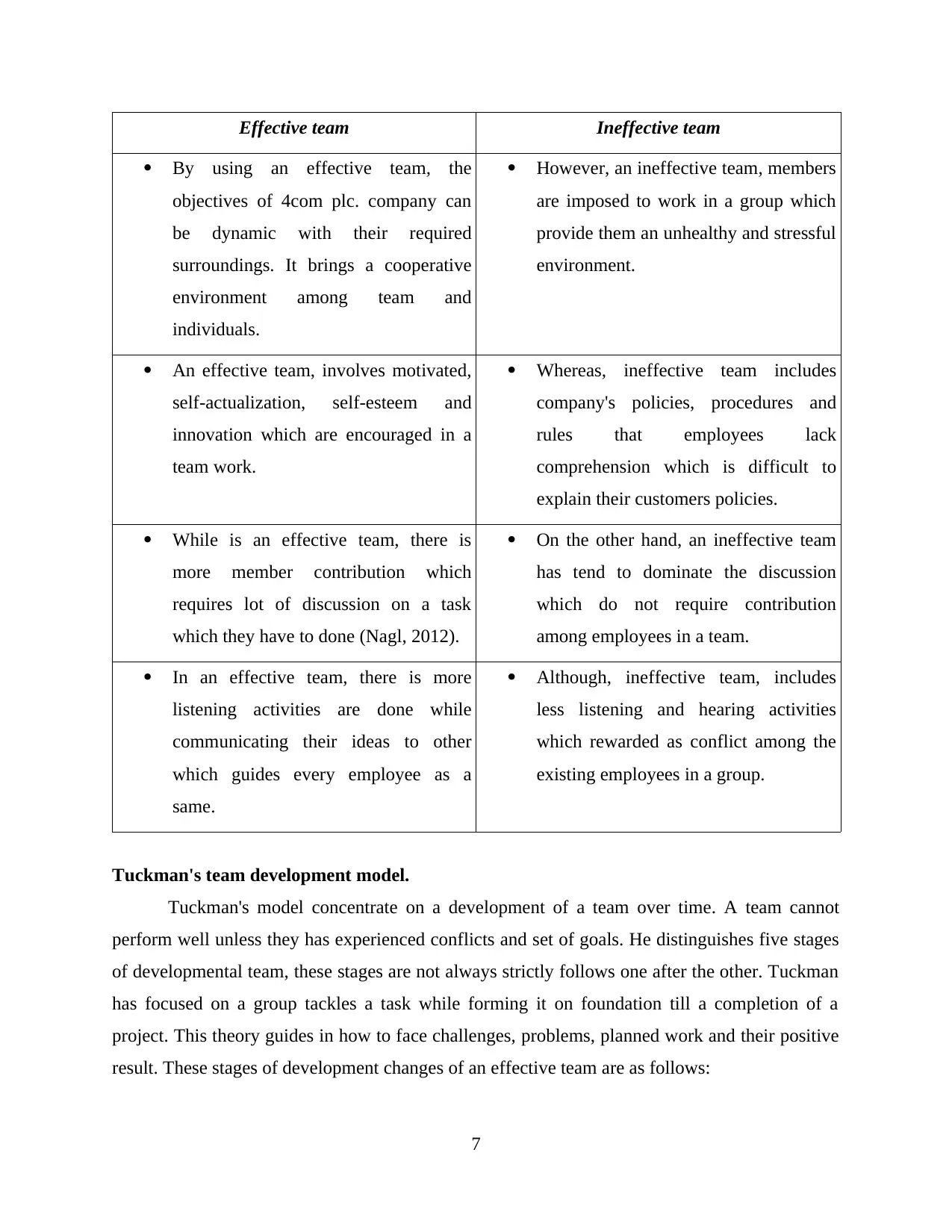
Effective team Ineffective team
By using an effective team, the
objectives of 4com plc. company can
be dynamic with their required
surroundings. It brings a cooperative
environment among team and
individuals.
However, an ineffective team, members
are imposed to work in a group which
provide them an unhealthy and stressful
environment.
An effective team, involves motivated,
self-actualization, self-esteem and
innovation which are encouraged in a
team work.
Whereas, ineffective team includes
company's policies, procedures and
rules that employees lack
comprehension which is difficult to
explain their customers policies.
While is an effective team, there is
more member contribution which
requires lot of discussion on a task
which they have to done (Nagl, 2012).
On the other hand, an ineffective team
has tend to dominate the discussion
which do not require contribution
among employees in a team.
In an effective team, there is more
listening activities are done while
communicating their ideas to other
which guides every employee as a
same.
Although, ineffective team, includes
less listening and hearing activities
which rewarded as conflict among the
existing employees in a group.
Tuckman's team development model.
Tuckman's model concentrate on a development of a team over time. A team cannot
perform well unless they has experienced conflicts and set of goals. He distinguishes five stages
of developmental team, these stages are not always strictly follows one after the other. Tuckman
has focused on a group tackles a task while forming it on foundation till a completion of a
project. This theory guides in how to face challenges, problems, planned work and their positive
result. These stages of development changes of an effective team are as follows:
7
By using an effective team, the
objectives of 4com plc. company can
be dynamic with their required
surroundings. It brings a cooperative
environment among team and
individuals.
However, an ineffective team, members
are imposed to work in a group which
provide them an unhealthy and stressful
environment.
An effective team, involves motivated,
self-actualization, self-esteem and
innovation which are encouraged in a
team work.
Whereas, ineffective team includes
company's policies, procedures and
rules that employees lack
comprehension which is difficult to
explain their customers policies.
While is an effective team, there is
more member contribution which
requires lot of discussion on a task
which they have to done (Nagl, 2012).
On the other hand, an ineffective team
has tend to dominate the discussion
which do not require contribution
among employees in a team.
In an effective team, there is more
listening activities are done while
communicating their ideas to other
which guides every employee as a
same.
Although, ineffective team, includes
less listening and hearing activities
which rewarded as conflict among the
existing employees in a group.
Tuckman's team development model.
Tuckman's model concentrate on a development of a team over time. A team cannot
perform well unless they has experienced conflicts and set of goals. He distinguishes five stages
of developmental team, these stages are not always strictly follows one after the other. Tuckman
has focused on a group tackles a task while forming it on foundation till a completion of a
project. This theory guides in how to face challenges, problems, planned work and their positive
result. These stages of development changes of an effective team are as follows:
7

Forming: It is a first stage of development of an effective team, it concentrate on initial
or starting stage, while building up with relationship with a team and clarifying mission
and their end result (Bennett and Lemoine, 2014). This stage assist in developing
company and understanding leadership roles. Forming stage involves outcome such as
delegating of authority to their juniors, responsibilities towards subordinate and
accountability while understanding team purpose and so on.
Storming: It is a second developmental stage of an effective team which includes the
comfort zone of their employees while expressing their views and opinion related to a
topic which are being discussed in a group of 4com plc. company. By using this
technique it will help in reducing conflict among members and co-workers due to
expressing their views on topic (Ljungholm, 2014). This will helps in determining nature
of other employees which guide them in near future by tackle circumstances.
Norming: It is a third developmental stage of an effective team, it includes the risk
during this stage is that team becomes self-satisfied and loses their creativity which
brought them on this phase of 4com plc. company. Norming tends to move towards
harmony working practices with team which they operate.
Performing: This is a fourth developmental stage of an effective team which all teams
members know exactly what is expected while performing work together towards goals
and objectives of 4com plc. company. Team members understand the goals and support
them. In performing stage team functions better and are enough of making decisions
independently.
Adjourning: This is a last stage of tuck man theory where an effective team gets
divided, when project is completed successfully. This process can be stressful of
employees at the time of dissolution of a plan (Colarelli and Arvey, 2015). This may
become a major problem for employees by labour turnover, absenteeism and many more.
TASK 4
P4. Concepts and philosophies of organisational behaviour
Organizational behaviour is a field to analyse impact of an individual behaviour within an
organization. This can improve the organisation effectiveness and assist them in achieving goals
towards a business enterprise. In order to accomplishes these objectives HR manager may adopt
8
or starting stage, while building up with relationship with a team and clarifying mission
and their end result (Bennett and Lemoine, 2014). This stage assist in developing
company and understanding leadership roles. Forming stage involves outcome such as
delegating of authority to their juniors, responsibilities towards subordinate and
accountability while understanding team purpose and so on.
Storming: It is a second developmental stage of an effective team which includes the
comfort zone of their employees while expressing their views and opinion related to a
topic which are being discussed in a group of 4com plc. company. By using this
technique it will help in reducing conflict among members and co-workers due to
expressing their views on topic (Ljungholm, 2014). This will helps in determining nature
of other employees which guide them in near future by tackle circumstances.
Norming: It is a third developmental stage of an effective team, it includes the risk
during this stage is that team becomes self-satisfied and loses their creativity which
brought them on this phase of 4com plc. company. Norming tends to move towards
harmony working practices with team which they operate.
Performing: This is a fourth developmental stage of an effective team which all teams
members know exactly what is expected while performing work together towards goals
and objectives of 4com plc. company. Team members understand the goals and support
them. In performing stage team functions better and are enough of making decisions
independently.
Adjourning: This is a last stage of tuck man theory where an effective team gets
divided, when project is completed successfully. This process can be stressful of
employees at the time of dissolution of a plan (Colarelli and Arvey, 2015). This may
become a major problem for employees by labour turnover, absenteeism and many more.
TASK 4
P4. Concepts and philosophies of organisational behaviour
Organizational behaviour is a field to analyse impact of an individual behaviour within an
organization. This can improve the organisation effectiveness and assist them in achieving goals
towards a business enterprise. In order to accomplishes these objectives HR manager may adopt
8
Secure Best Marks with AI Grader
Need help grading? Try our AI Grader for instant feedback on your assignments.
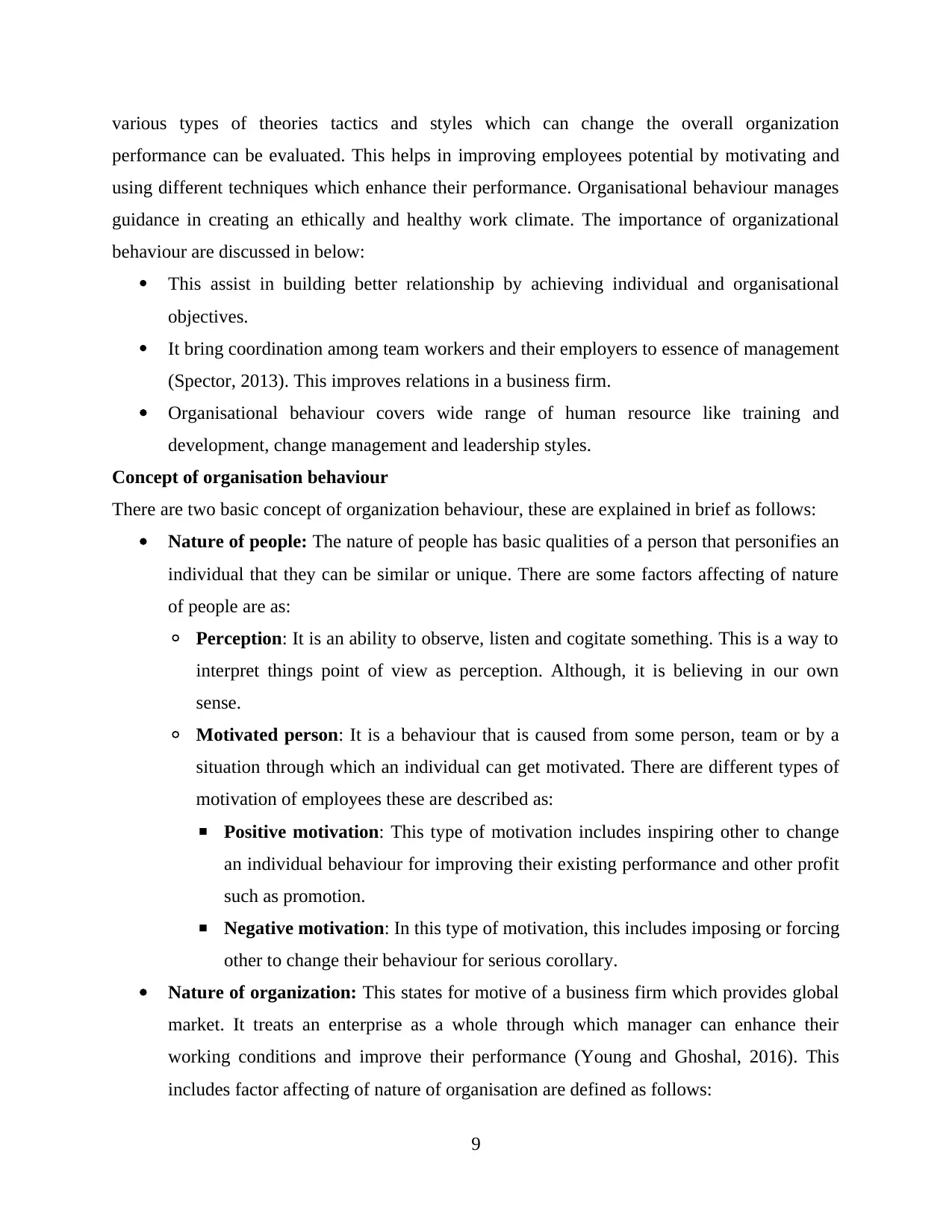
various types of theories tactics and styles which can change the overall organization
performance can be evaluated. This helps in improving employees potential by motivating and
using different techniques which enhance their performance. Organisational behaviour manages
guidance in creating an ethically and healthy work climate. The importance of organizational
behaviour are discussed in below:
This assist in building better relationship by achieving individual and organisational
objectives.
It bring coordination among team workers and their employers to essence of management
(Spector, 2013). This improves relations in a business firm.
Organisational behaviour covers wide range of human resource like training and
development, change management and leadership styles.
Concept of organisation behaviour
There are two basic concept of organization behaviour, these are explained in brief as follows:
Nature of people: The nature of people has basic qualities of a person that personifies an
individual that they can be similar or unique. There are some factors affecting of nature
of people are as:
◦ Perception: It is an ability to observe, listen and cogitate something. This is a way to
interpret things point of view as perception. Although, it is believing in our own
sense.
◦ Motivated person: It is a behaviour that is caused from some person, team or by a
situation through which an individual can get motivated. There are different types of
motivation of employees these are described as:
▪ Positive motivation: This type of motivation includes inspiring other to change
an individual behaviour for improving their existing performance and other profit
such as promotion.
▪ Negative motivation: In this type of motivation, this includes imposing or forcing
other to change their behaviour for serious corollary.
Nature of organization: This states for motive of a business firm which provides global
market. It treats an enterprise as a whole through which manager can enhance their
working conditions and improve their performance (Young and Ghoshal, 2016). This
includes factor affecting of nature of organisation are defined as follows:
9
performance can be evaluated. This helps in improving employees potential by motivating and
using different techniques which enhance their performance. Organisational behaviour manages
guidance in creating an ethically and healthy work climate. The importance of organizational
behaviour are discussed in below:
This assist in building better relationship by achieving individual and organisational
objectives.
It bring coordination among team workers and their employers to essence of management
(Spector, 2013). This improves relations in a business firm.
Organisational behaviour covers wide range of human resource like training and
development, change management and leadership styles.
Concept of organisation behaviour
There are two basic concept of organization behaviour, these are explained in brief as follows:
Nature of people: The nature of people has basic qualities of a person that personifies an
individual that they can be similar or unique. There are some factors affecting of nature
of people are as:
◦ Perception: It is an ability to observe, listen and cogitate something. This is a way to
interpret things point of view as perception. Although, it is believing in our own
sense.
◦ Motivated person: It is a behaviour that is caused from some person, team or by a
situation through which an individual can get motivated. There are different types of
motivation of employees these are described as:
▪ Positive motivation: This type of motivation includes inspiring other to change
an individual behaviour for improving their existing performance and other profit
such as promotion.
▪ Negative motivation: In this type of motivation, this includes imposing or forcing
other to change their behaviour for serious corollary.
Nature of organization: This states for motive of a business firm which provides global
market. It treats an enterprise as a whole through which manager can enhance their
working conditions and improve their performance (Young and Ghoshal, 2016). This
includes factor affecting of nature of organisation are defined as follows:
9
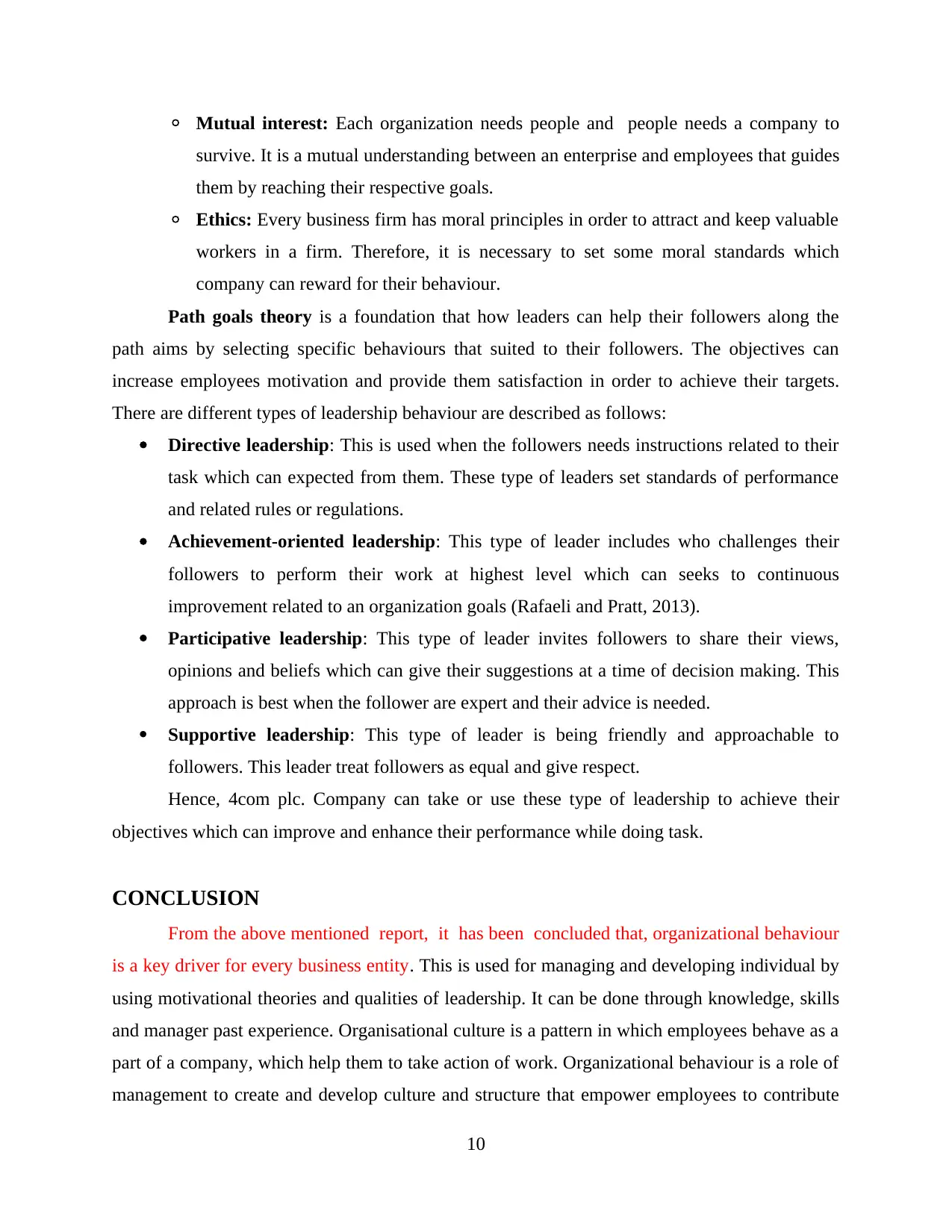
◦ Mutual interest: Each organization needs people and people needs a company to
survive. It is a mutual understanding between an enterprise and employees that guides
them by reaching their respective goals.
◦ Ethics: Every business firm has moral principles in order to attract and keep valuable
workers in a firm. Therefore, it is necessary to set some moral standards which
company can reward for their behaviour.
Path goals theory is a foundation that how leaders can help their followers along the
path aims by selecting specific behaviours that suited to their followers. The objectives can
increase employees motivation and provide them satisfaction in order to achieve their targets.
There are different types of leadership behaviour are described as follows:
Directive leadership: This is used when the followers needs instructions related to their
task which can expected from them. These type of leaders set standards of performance
and related rules or regulations.
Achievement-oriented leadership: This type of leader includes who challenges their
followers to perform their work at highest level which can seeks to continuous
improvement related to an organization goals (Rafaeli and Pratt, 2013).
Participative leadership: This type of leader invites followers to share their views,
opinions and beliefs which can give their suggestions at a time of decision making. This
approach is best when the follower are expert and their advice is needed.
Supportive leadership: This type of leader is being friendly and approachable to
followers. This leader treat followers as equal and give respect.
Hence, 4com plc. Company can take or use these type of leadership to achieve their
objectives which can improve and enhance their performance while doing task.
CONCLUSION
From the above mentioned report, it has been concluded that, organizational behaviour
is a key driver for every business entity. This is used for managing and developing individual by
using motivational theories and qualities of leadership. It can be done through knowledge, skills
and manager past experience. Organisational culture is a pattern in which employees behave as a
part of a company, which help them to take action of work. Organizational behaviour is a role of
management to create and develop culture and structure that empower employees to contribute
10
survive. It is a mutual understanding between an enterprise and employees that guides
them by reaching their respective goals.
◦ Ethics: Every business firm has moral principles in order to attract and keep valuable
workers in a firm. Therefore, it is necessary to set some moral standards which
company can reward for their behaviour.
Path goals theory is a foundation that how leaders can help their followers along the
path aims by selecting specific behaviours that suited to their followers. The objectives can
increase employees motivation and provide them satisfaction in order to achieve their targets.
There are different types of leadership behaviour are described as follows:
Directive leadership: This is used when the followers needs instructions related to their
task which can expected from them. These type of leaders set standards of performance
and related rules or regulations.
Achievement-oriented leadership: This type of leader includes who challenges their
followers to perform their work at highest level which can seeks to continuous
improvement related to an organization goals (Rafaeli and Pratt, 2013).
Participative leadership: This type of leader invites followers to share their views,
opinions and beliefs which can give their suggestions at a time of decision making. This
approach is best when the follower are expert and their advice is needed.
Supportive leadership: This type of leader is being friendly and approachable to
followers. This leader treat followers as equal and give respect.
Hence, 4com plc. Company can take or use these type of leadership to achieve their
objectives which can improve and enhance their performance while doing task.
CONCLUSION
From the above mentioned report, it has been concluded that, organizational behaviour
is a key driver for every business entity. This is used for managing and developing individual by
using motivational theories and qualities of leadership. It can be done through knowledge, skills
and manager past experience. Organisational culture is a pattern in which employees behave as a
part of a company, which help them to take action of work. Organizational behaviour is a role of
management to create and develop culture and structure that empower employees to contribute
10
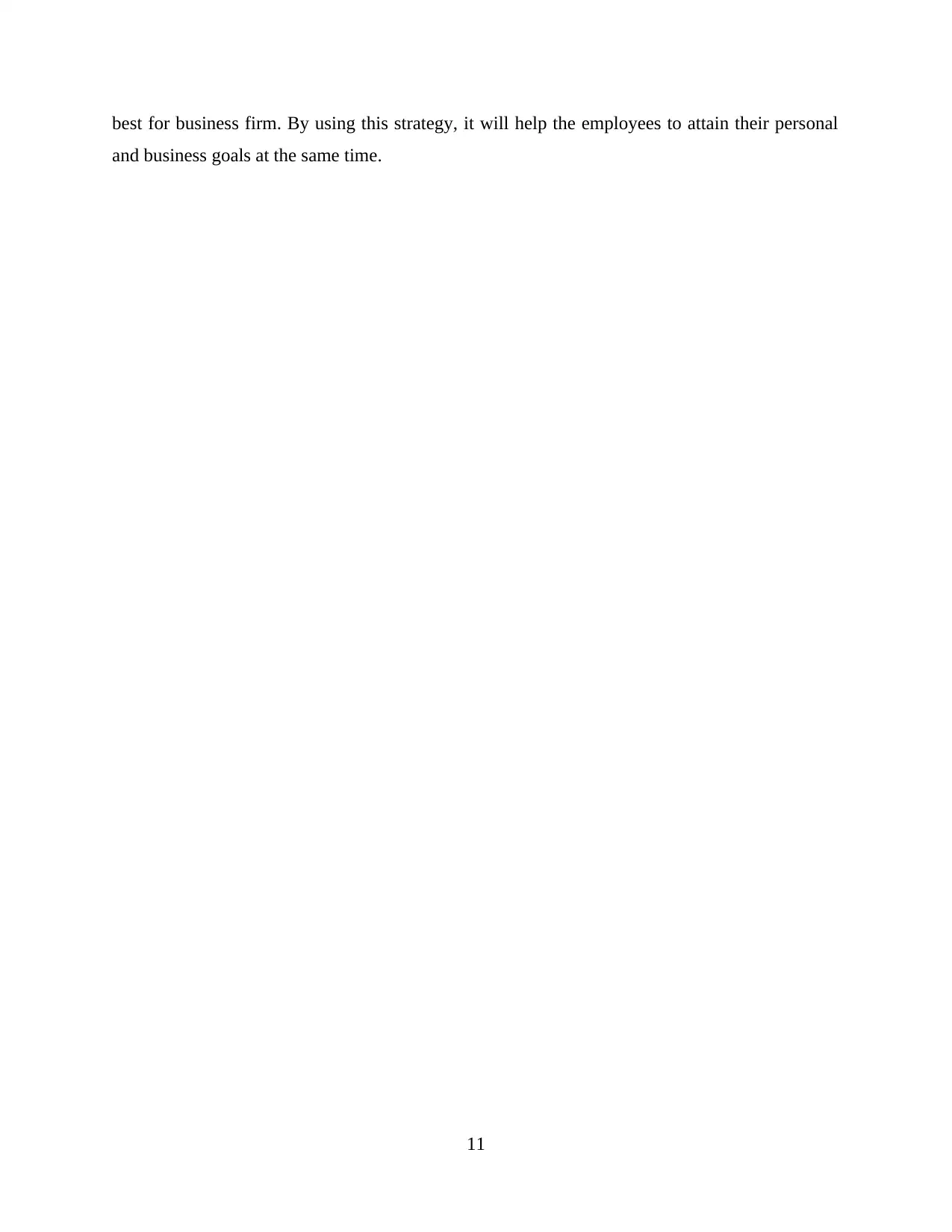
best for business firm. By using this strategy, it will help the employees to attain their personal
and business goals at the same time.
11
and business goals at the same time.
11
Paraphrase This Document
Need a fresh take? Get an instant paraphrase of this document with our AI Paraphraser
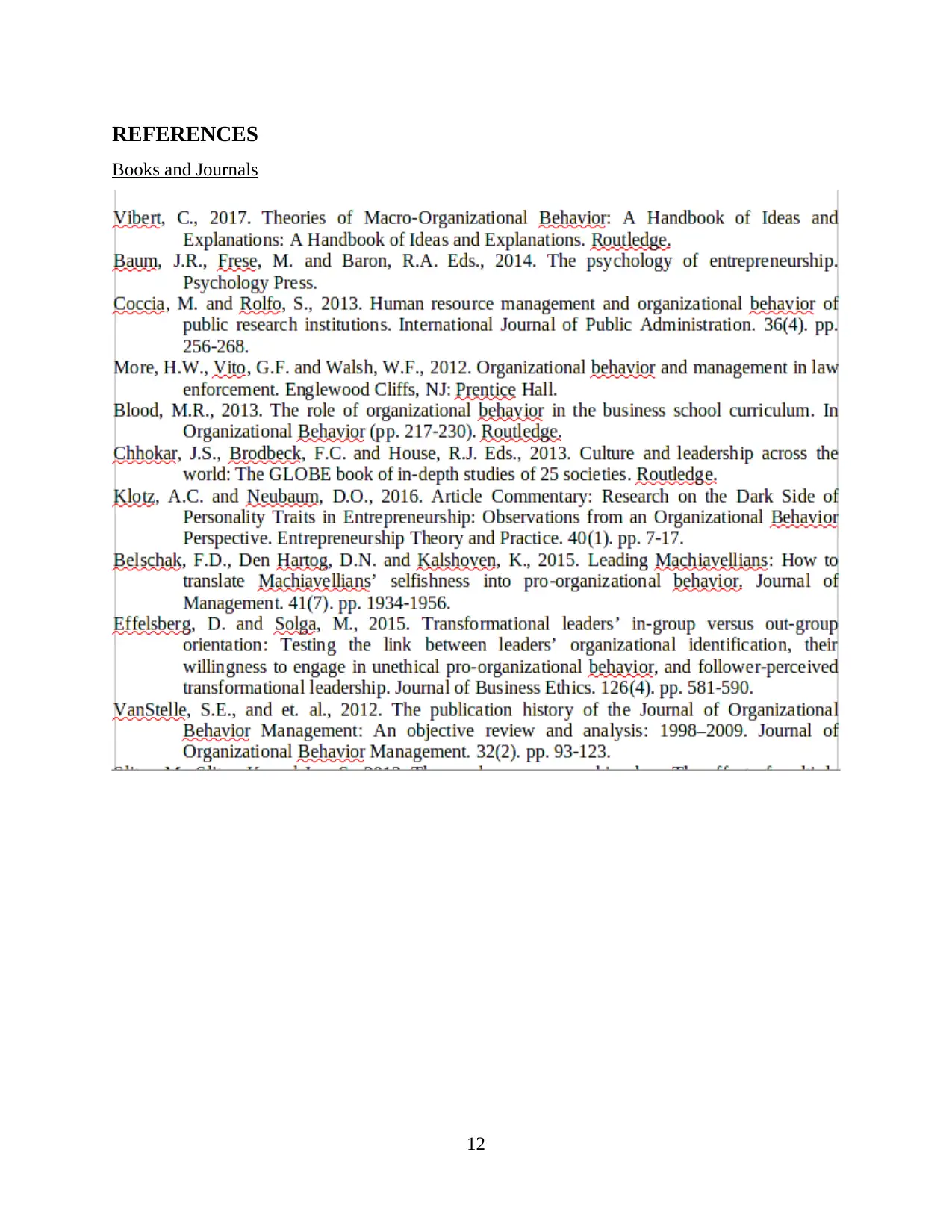
REFERENCES
Books and Journals
12
Books and Journals
12

13
1 out of 15
Related Documents
Your All-in-One AI-Powered Toolkit for Academic Success.
+13062052269
info@desklib.com
Available 24*7 on WhatsApp / Email
![[object Object]](/_next/static/media/star-bottom.7253800d.svg)
Unlock your academic potential
© 2024 | Zucol Services PVT LTD | All rights reserved.





